What Makes It Noir?
French critics in the years immediately following World War II took notice of the writings of American authors Dashiell Hammett, Raymond Chandler, James M. Cain, and others, and went on to note that “Americans also make noir films.” Heretofore, such hardboiled crime stories had been referred to as Crime Melodramas.
“Film Noir” has been used to describe many different films over the years. Film critic Raymond Durgnat’s position is that film noir is not a genre at all, but is defined by tone rather than genre. However, this definition seems to me to be too broad to be of any use when discussing the genre, and yes, I consider Film Noir a genre.
Nouveau Noir
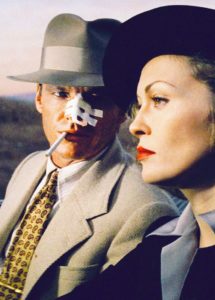
Many fine films have been called Film Noir, such as Lawrence Kasdan’s Body Heat, 1981, Robert Altman’s The Long Goodbye, 1973, and my personal favorite, Roman Polanski’s Chinatown, 1974. (Note that the aforementioned films were shot in color and, therefore, lack the exquisitely subtle shades of black and white photography usually associated with classic Film Noir.) More importantly, these films belong to the era of the New Hollywood (c.1967-1981) and are postmodern, deconstructive in form. The protagonists in these films are inept and unprepared to meet the challenges before them as opposed to the heroes of classic Film Noir such as, for example, Howard Hawks’ The Big Sleep, 1946, in which Philip Marlowe (the epitome of the hardboiled private detective played by Humphrey Bogart) is on top of his game and in control even when that appears not to be the case.
Classic Film Noir

To my mind, classic Film Noir began with John Huston’s The Maltese Falcon, 1941, and ended with Orson Welles’s Touch of Evil, 1958. These films reflect their times and became increasingly dark. Although originally written in 1929, The Maltese Falcon, from the novel by Dashiell Hammett, was produced on the eve of America’s entry into World War II when Europe and Asia were already under the storm clouds of war. This now famous version was the third film remake of the story. The first version was produced in 1931 and the second in 1936 with the title, Satan Met a Lady, but it is the 1941 version with the definitive dark mood and look that exemplifies Film Noir.
Femme Fatale
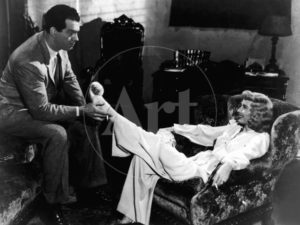
With the approach of the war’s end, a new malaise gripped the country. Returning veterans came home, their youth chewed up by the savagery of combat, only to find high unemployment and despair. In the absence of the men in uniform, the nation’s women had been called into service to fulfill the labor demands of the wartime economy. Women came to enjoy the freedom of working outside the home as well as the increased security of a paycheck. Resentment grew toward these newly liberated women. This bitterness can be found in the prevalence of the femme fatale in such films as Billy Wilder’s Double Indemnity, 1944, and Orson Welles’s The Lady from Shanghai, 1947. Ambitious women, who had to first be punished and then rescued by a man, were also a target for disdain. Michael Curtiz’ wonderful film, Mildred Pierce, 1945, is an excellent example of the disapproval of competent women in post-war America.
The Red Scare
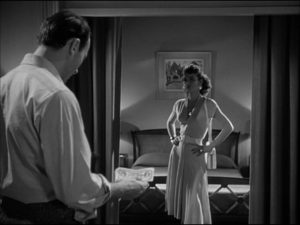
With the coming of the cold war, a shift in the nation’s psyche, bordering on paranoia, not surprisingly, found its way into films. Typical of the period are Samuel Fuller’s Pickup on South Street, 1953, and Robert Aldrich’s Kiss Me Deadly, 1955, in which the roles of common criminals are superseded by enemy agents intent in destroying the American way of life. However after the “red scare” of the McCarthy era subsided, the themes of Film Noir returned to relative normalcy in which the antagonists resumed criminal activities on a far lesser scale than world domination.
Corruption

A new order began emerging in which good and evil were no longer clear-cut. This sentiment was reflected in film. (Film in general being reactive rather than proactive in matters of social consciousness). Orson Welles’ Touch of Evil, 1958, which serves as a bookend to the era of classic Film Noir, is a fine example of this change in the national humor with its focus on corruption in offices of authority. Orson Welles plays corrupt Police Captain Hank Quinlan at odds with courageous Miguel Vargas, a Mexican law enforcement officer. It must be noted that Miguel Vargas is played by Charlton Heston in dark makeup as Hollywood was still years away of portraying a heroic Hispanic man with a Hispanic actor.
Lighting
However, dark subjects alone do not make a movie fit neatly into the canon of Film Noir. Films from the classic period are as defined as much by their look as by their themes.
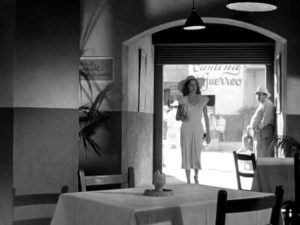
Lighting is of particular importance in defining the genre. Abandoning the technique of a strong key light near the camera and a muted fill light to the side to soften shadows used in common three-point lighting , noir lighting reverses the lighting to produce high contrast and deep, often jagged, shadows to add drama. Two other devices often found in Film Noir are strong back-lighting to cast characters in dark silhouette or the opposite, equal lighting of both characters and settings with the use of unusual composition in the frame to add dramatic effect.
Mise-en-Scène
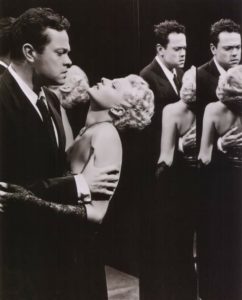
The mise-en-scène found in classic Film Noir also adds significant tension. Typically shot at night, exterior scenes feature waterfront docks, dark alleyways, and empty streets often glistening wet as if it has just rained (even in Los Angeles), and interior scenes are often shot in nightclubs, casinos, or taverns. The aforementioned femme fatale or fallen woman, who leads or attempts to lead the hero to his mortal or moral doom or both, is nearly always present. Orientalism—subtly suggesting exoticism, eroticism, and mystery—is also found in many Films Noir.
And so…
As I stated in the beginning, the term Film Noir has been used to describe a great many films, and one’s view of what makes a film a Film Noir varies greatly. I can leave you with this thought from critic Marc Vernet’s “Film Noir on the Edge of Doom, “On the whole, film noir is like a Harley-Davidson: you know right away what it is…”
